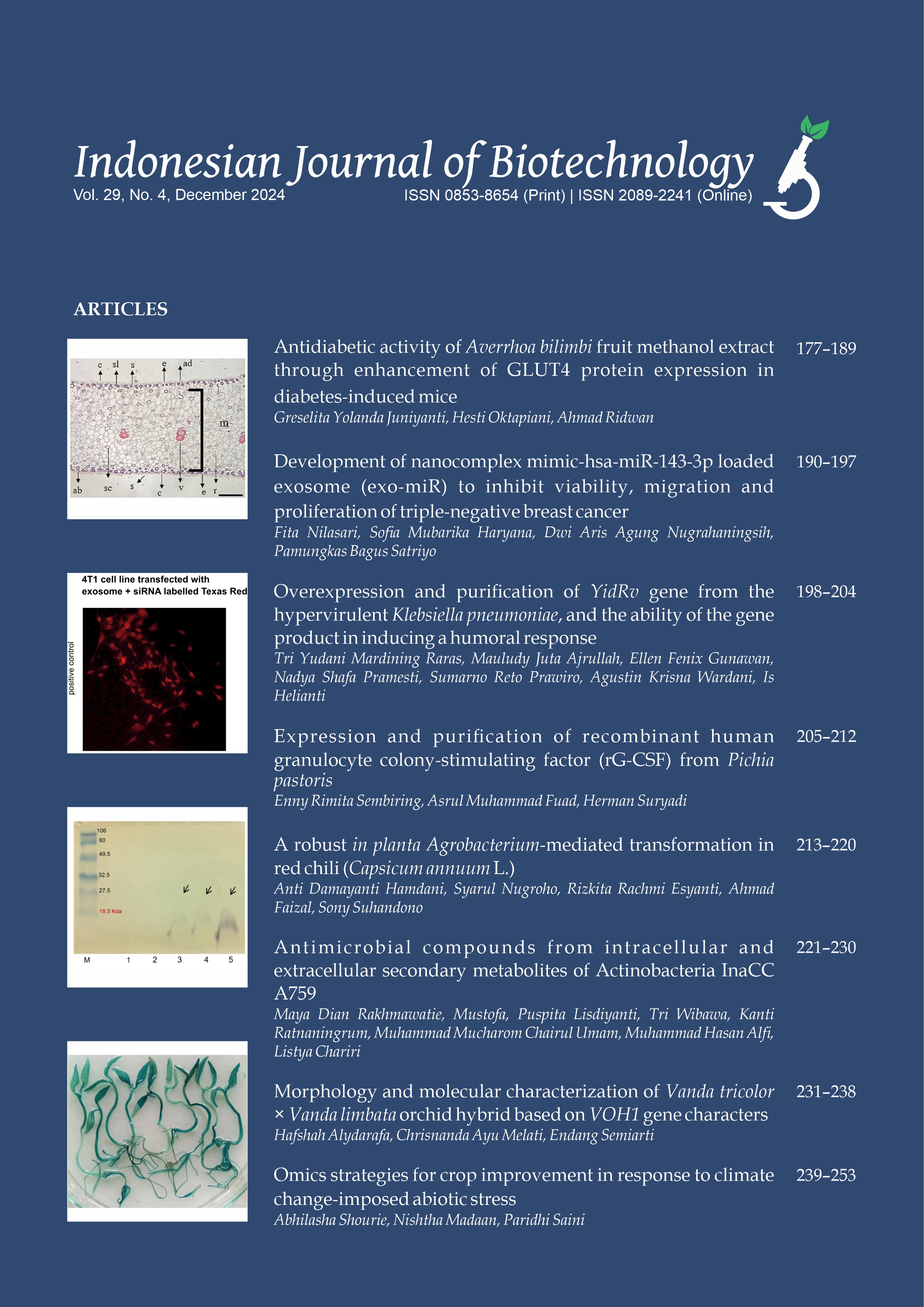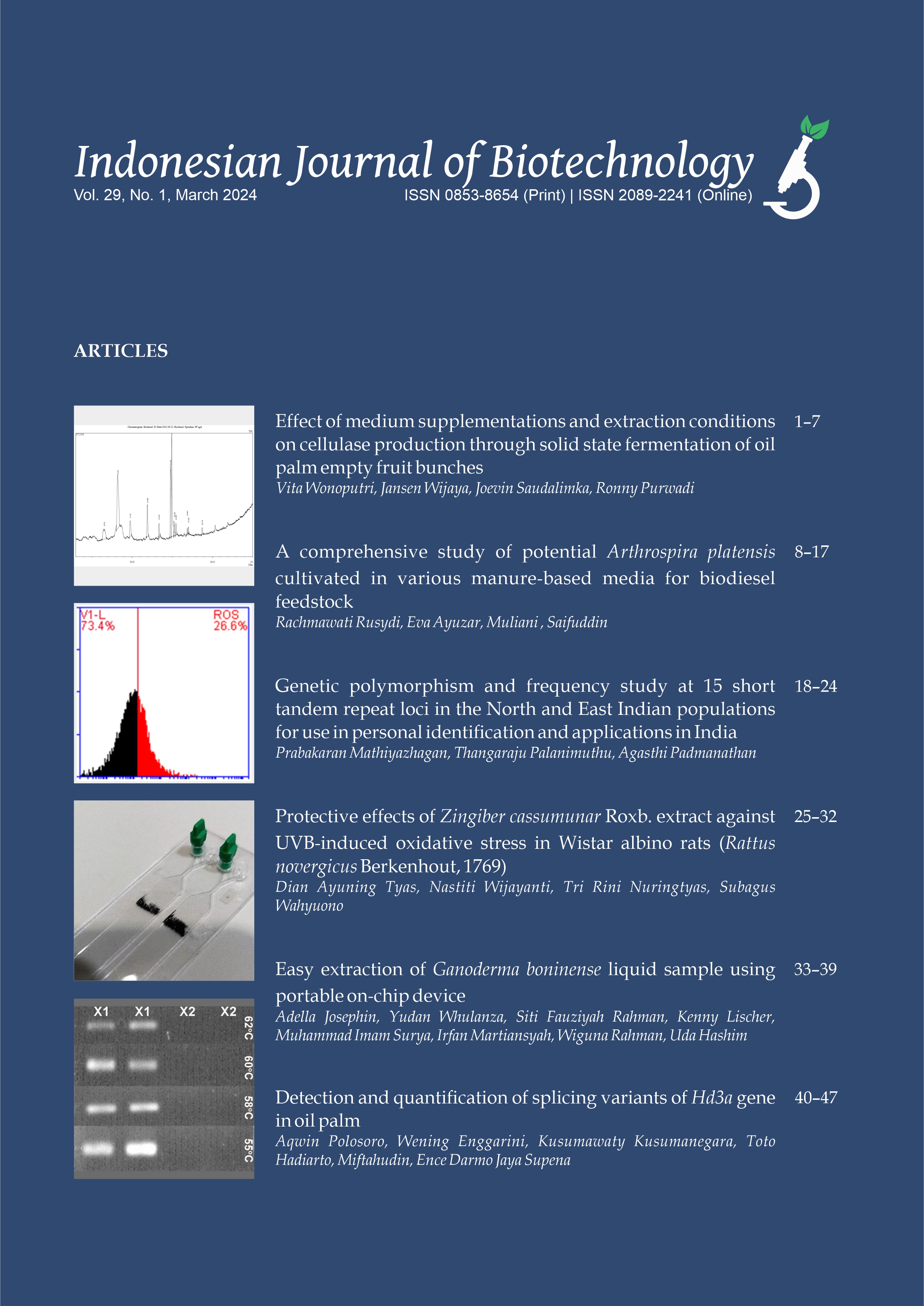Genes expression analysis of EgUnk1, EgZFP2, and EgIPK2b in oil palm using Ct value correction and two relative quantification approaches
Rokhana Faizah(1*), Riza Arief Putranto(2), Sudarsono Sudarsono(3), Sri Wening(4), Dewi Sukma(5), Asmini Budiani(6)
(1) Plant Breeding and Biotechnology Study Program, Department of Agronomy and Horticulture, Faculty of Agriculture, Bogor Agricultural University (IPB University), Jl. Meranti, Dramaga Campus, Bogor 16680, Indonesia; Indonesian Oil Palm Research Institute, Jl. Brigjen Katamso No. 51 Medan 20158, North Sumatera, Indonesia; PT Riset Perkebunan Nusantara (Nusantara Estate Crops Research). Jl. Salak No. 1A, Bogor 16128, Indonesia
(2) Indonesian Oil Palm Research Institute, Jl. Brigjen Katamso No. 51 Medan 20158, North Sumatera, Indonesia
(3) Department of Agronomy and Horticulture, Faculty of Agriculture, Bogor Agricutural University (IPB University). Jl. Meranti, Dramaga Campus, Bogor 16680, Indonesia
(4) Indonesian Oil Palm Research Institute, Jl. Brigjen Katamso No. 51 Medan 20158, North Sumatera, Indonesia; PT Riset Perkebunan Nusantara (Nusantara Estate Crops Research). Jl. Salak No. 1A, Bogor 16128, Indonesia
(5) Department of Agronomy and Horticulture, Faculty of Agriculture, Bogor Agricutural University (IPB University). Jl. Meranti, Dramaga Campus, Bogor 16680, Indonesia
(6) Indonesian Oil Palm Research Institute, Jl. Brigjen Katamso No. 51 Medan 20158, North Sumatera, Indonesia
(*) Corresponding Author
Abstract
The determination of transcript accumulation values significantly affects gene expression in oil palm. Various genes are involved in pathogen infection, including probable 2‐oxoglutarate‐dependent dioxygenase At5g05600 (EgUnk3), zinc finger protein 2‐like (EgZFP2), and inositol polyphosphate multikinase beta‐like (EgIPK2b). Gene expression is typically measured using relative quantitative methods to calculate differences in quantitative values in the expression levels of targeted genes compared to a reference gene. However, the effectiveness of these methods in assessing the expression of EgUnk3, EgZFP2, and EgIPK2b, which are involved in Ganoderma boninense infection in oil palm seedlings, requires evaluation. This study aimed to establish an effective and straightforward method for analyzing the expression of EgUnk1, EgZFP2, and EgIPK2b genes in oil palm seedlings infected with G. boninense, utilizing Ct value correction through regression coefficients on the 2‐ΔΔCtand E‐ΔΔCtapproaches. A correlation regression revealed values of 0.28, ‐0.32, and 0.29 for delta Ct of EgUnk1, EgZFP2, and EgIPK2b, respectively. However, a negative correlation in the Ct mean was corrected by linear regression for the targeted genes: ‐0.55, ‐0.81, and ‐0.29 for EgUnk1, EgZFP2, and EgIPK2b, respectively. The amplification factor (E) and efficiency value (R) using the EgActin gene were 1.95 and 94.92%, respectively. Normalization of log10 on the fold change value 2‐ΔΔCtand 1.95‐ΔΔCtapproaches using the regression coefficient yielded consistent results for the EgUnk1, EgZFP2, and EgIPK2b genes. Overall, EgUnk3 and EgIPK2b genes exhibited downregulated expression in susceptible oil palm seedlings (‐0.60 for 2(‐ΔΔCt)and ‐0.58 for 1.95(‐ΔΔCt)), whereas EgIPK2b gene showed up‐regulated and the highest value in inoculated resistant seedlings (1.39 for 2(‐ΔΔCt)and 1.34 for 1.95(‐ΔΔCt)). Basal stem rot disease (BSR) in oil palm decreased EgUnk1 and EgIPK2b expression in susceptible seedlings but increased EgZFP2 gene expression in resistant ones. The results of this research provide valuable corrections to Ct values obtained directly from RT‐qPCR machines using simple linear regression. Consequently, the Ct values of target genes and reference genes exhibit smaller bias values, rendering gene expression levels more reliable.
Keywords
Full Text:
PDFReferences
Adamski MG, Gumann P, Baird AE. 2014. A method for quantitative analysis of standard and highthroughput qPCR expression data based on input sample quantity. PLoS One 9(8):e103917. doi:10.1371/journal.pone.0103917.
Boulter N, Suarez FG, Schibeci S, Sunderland T, Tolhurst O, Hunter T, Hodge G, Handelsman D, Simanainen U, Hendriks E, Duggan K. 2016. A simple, accurate and universal method for quantification of PCR. BMC Biotechnol. 16:27. doi:10.1186/s128960160256y.
Cantarero A, Andrade P, Carneiro M, MorenoBorrallo A, AlonsoAlvarez C. 2020. Testing the carotenoidbased sexual signalling mechanism by altering CYP2J19 gene expression and colour in a bird species: Red ketocarotenoid signalling mechanism. Proc. R. Soc. B Biol. Sci. 287(1938):20201067. doi:10.1098/rspb.2020.1067.
Chan PL, Rose RJ, Abdul Murad AM, Zainal Z, Leslie Low ET, Ooi LCL, Ooi SE, Yahya S, Singh R. 2014. Evaluation of reference genes for quantitative realtime PCR in oil palm elite planting materials propagated by tissue culture. PLoS One 9(6):e99774. doi:10.1371/journal.pone.0099774.
Chow YY, Rahman S, Ting ASY. 2019. Evaluating the host defense responses in oil palm to complex biocontrol endophyte–pathogen–host plant interaction via Fluidigm® realtime polymerase chain reaction (RTPCR). Biol. Control 129:148–157. doi:10.1016/j.biocontrol.2018.10.011.
Cui X, Yu S, Tamhane A, Causey ZL, Steg A, Danila MI, Reynolds RJ, Wang J, Wanzeck KC, Tang Q, Ledbetter SS, Redden DT, Johnson MR, Bridges SL. 2015. Simple regression for correcting δCt bias in RTqPCR lowdensity array data normalization. BMC Genomics 16(1):82. doi:10.1186/s128640151274 1.
Faizah R, Putranto RA, Raharti VR, Supena N, Sukma D, Budiani A, Wening S, Sudarsono S. 2022. Defense response changes in roots of oil palm (Elaeis guineensis Jacq.) seedlings after internal symptoms of Ganoderma boninense Pat. infection. BMC Plant Biol. 22:139. doi:10.1186/s12870022034930.
Gupta SK, Rai AK, Kanwar SS, Sharma TR. 2012. Comparative analysis of zinc finger proteins involved in plant disease resistance. PLoS One 7(8):e42578. doi:10.1371/journal.pone.0042578.
Han G, Lu C, Guo J, Qiao Z, Sui N, Qiu N, Wang B. 2020. Corrigendum: C2H2 zinc finger proteins: Master regulators of abiotic stress responses in plants. Front. Plant Sci. 11:115. doi:10.3389/fpls.2020.00298.
Jia Q, Kong D, Li Q, Sun S, Song J, Zhu Y, Liang K, Ke Q, Lin W, Huang J. 2019. The function of inositol phosphatases in plant tolerance to abiotic stress. Int. J. Mol. Sci. 20(16):399. doi:10.3390/ijms20163999.
Josephin A, Whulanza Y, Rahman SF, Lischer K, Surya MI, Martiansyah I, Rahman W, Hashim U. 2024. Easy extraction of Ganoderma boninense liquid sample using portable onchip device. Indones. J. Biotechnol. 29(1):33–39. doi:10.22146/ijbiotech.83645.
Kakizaki T, Kitashiba H, Zou Z, Li F, Fukino N, Ohara T, Nishio T, Ishida M. 2017. A 2 oxoglutaratedependent dioxygenase mediates the biosynthesis of glucoraphasatin in radish. Plant Physiol. 173(3):1583–1593. doi:10.1104/pp.16.01814.
Kralik P, Ricchi M. 2017. A basic guide to real time PCR in microbial diagnostics: Definitions, parameters, and everything. Front. Microbiol. 8:108. doi:10.3389/fmicb.2017.00108.
Livak KJ, Schmittgen TD. 2001. Analysis of relative gene expression data using realtime quantitative PCR and the 2∆∆CT method. Methods 25(4):402–408. doi:10.1006/meth.2001.1262.
Ma H, Bell KN, Loker RN. 2021. qPCR and qRTPCR analysis: Regulatory points to consider when conducting biodistribution and vector shedding studies. Mol. Ther. Methods Clin. Dev. 20:152–168. doi:10.1016/j.omtm.2020.11.007.
Paul S, Singh S, Chakrabarti A, Rudramurthy SM, Ghosh AK. 2020. Selection and evaluation of appropriate reference genes for RTqPCR based expression analysis in Candida tropicalis following azole treatment. Sci. Rep. 10:1972. doi:10.1038/s41598020587447.
Pfaffl M. 2004. Quantification strategies in realtime PCR. La Jolla: International University Line (IUL). p. 87– 112.
Pfaffl M. 2007. Relative quantification. England: Taylor & Francis Group.
Pfaffl MW, Horgan GW, Dempfle L. 2002. Relative expression software tool (REST) for groupwise comparison and statistical analysis of relative expression results in realtime PCR. Nucleic Acids Res. 30(9):e36. doi:10.1093/nar/30.9.e36.
Polosoro A, Enggarini W, Kusumanegara K, Hadiarto T, Miftahudin M, Supena EDJ. 2024. Detection and quantification of splicing variants of Hd3a gene in oil palm. Indones. J. Biotechnol. 29(1):40–47. doi:10.22146/ijbiotech.88327.
Ramakers C, Ruijter JM, Lekanne Deprez RH, Moorman AF. 2003. Assumptionfree analysis of quantitative realtime polymerase chain reaction (PCR) data. Neurosci. Lett. 339(1):62–66. doi:10.1016/S0304 3940(02)014234.
Rao X, Huang X, Zhou Z, Lin X. 2013. An improvement of the 2ˆ(delta delta CT) method for quantitative realtime polymerase chain reaction data analysis. Biostat. Bioinforma. Biomath. 3(3):71–85.
Regier N, Frey B. 2010. Experimental comparison of relative RTqPCR quantification approaches for gene expression studies in poplar. BMC Mol. Biol. 11:57. doi:10.1186/147121991157.
RuizVillalba A, Ruijter JM, van den Hoff MJ. 2021. Use and misuse of Cq in qPCR data analysis and reporting. Life 11(6):496. doi:10.3390/life11060496.
SánchezPujante PJ, BorjaMartínez M, Pedreño MÁ, Almagro L. 2017. Biosynthesis and bioactivity of glucosinolates and their production in plant in vitro cultures. Planta 246(1):19–32. doi:10.1007/s00425017 27059.
Sanders R, Mason DJ, Foy CA, Huggett JF. 2014. Considerations for accurate gene expression measurement by reverse transcription quantitative PCR when analysing clinical samples. Anal. Bioanal. Chem. 406(26):6471–6483. doi:10.1007/s002160147857 x.
Schmittgen TD, Livak KJ. 2008. Analyzing realtime PCR data by the comparative CT method. Nat. Protoc. 3(6):1101–1108. doi:10.1038/nprot.2008.73.
Sun Z, Kuczek T, Zhu Y. 2014. Statistical calibration of QRTPCR, microarray and RNASeq gene expression data with measurement error models. Ann. Appl. Stat. 8(2):1022–1044. doi:10.1214/14AOAS721.
Svec D, Tichopad A, Novosadova V, Pfaffl MW, Kubista M. 2015. How good is a PCR efficiency estimate: Recommendations for precise and robust qPCR efficiency assessments. Biomol. Detect. Quantif. 3:9–16. doi:10.1016/j.bdq.2015.01.005.
Wang Q, Song S, Lu X, Wang Y, Chen Y, Wu X, Tan L, Chai G. 2022. Hormone regulation of CCCH zinc finger proteins in plants. Int. J. Mol. Sci. 23(22):14288. doi:10.3390/ijms232214288.
Wu Z, Shen S, Wang Y, Tao W, Zhao Z, Hu X, Yu P. 2022. Genomewide identification and expression analysis of the zinc finger protein gene subfamilies under drought stress in Triticum aestivum. Plants 11(19):2511. doi:10.3390/plants11192511.
Yang Q, Sang S, Chen Y, Wei Z, Wang P. 2017. The role of Arabidopsis inositol polyphosphate kinase AtIPK2β in glucose suppression of seed germination and seedling development. Plant Cell Physiol. 59(2):343–354. doi:10.1093/pcp/pcx186.
Zhang H, Zhao T, Zhuang P, Song Z, Du H, Tang Z, Gao Z. 2016. NbCZF1, a novel C2H2type zinc finger protein, as a new regulator of SsCutinduced plant immunity in Nicotiana benthamiana. Plant Cell Physiol. 57(12):2472–2484. doi:10.1093/pcp/pcw160.
Zhao F, Maren NA, Kosentka PZ, Liao YY, Lu H, Duduit JR, Huang D, Ashrafi H, Zhao T, Huerta AI, Ranney TG, Liu W. 2021. An optimized protocol for stepwise optimization of realtime RTPCR analysis. Hortic. Res. 8:179. doi:10.1038/s4143802100616w.
Zuhar LM, Madihah AZ, Ahmad SA, Zainal Z, Idris AS, Shaharuddin NA. 2021. Identification of oil palm’s consistently upregulated genes during early infections of Ganoderma boninense via RNAseq technology and realtime quantitative PCR. Plants 10(10):2026. doi:10.3390/plants10102026.
Zuhar LM, Madinah AZ, Ahmad SA, Zainal Z, Idris AS, Shaharuddin NA. 2019. Determination of reference genes for normalisation of gene expression study of Ganodermainfected oil palms. J. Oil Palm Res. 31(4):550–560. doi:10.21894/jopr.2019.0051.
Article Metrics
Refbacks
- There are currently no refbacks.
Copyright (c) 2024 The Author(s)

This work is licensed under a Creative Commons Attribution-ShareAlike 4.0 International License.









